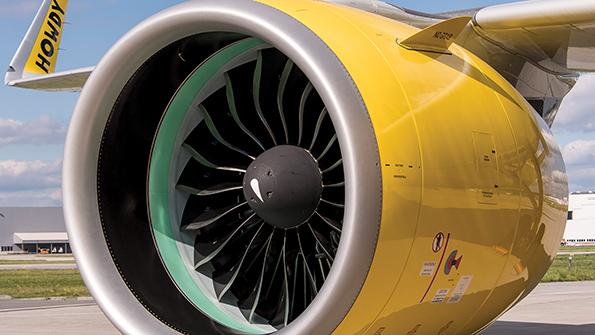
When the Paris Airshow opens its gates in mid-June—for the first time since 2019—it’s a sure bet that air transport sustainability will be a top agenda item. Another big talking point, however, will be the industry supply chain.
Airlines are resurrecting their long-term fleet renewal plans and, in some cases, starting to place large new aircraft orders. Demand for air travel is surging and airlines, understandably, are keen to sell every seat on every route they can.
But the post-pandemic ramp-up is being hindered operationally by labor shortages (across the air transport system), strike actions, and shortages of aircraft, engines, aerospace parts and materials. Of all the operational challenges, however, it’s that last part—the supply chain—that is most vexing and costly for airlines. It’s bad enough having to plan around new aircraft delivery delays, but there are usually workarounds, such as leasing aircraft or holding on to older planes. But when relatively new aircraft in an airline’s fleet are forced to sit on the ground because of engines that need fixing, the airline is paying for an expensive asset it can’t use.
That’s the situation many airlines have found themselves in with their Pratt & Whitney PW1000G-powered narrowbodies. And as the issue has dragged out, airline executives are losing patience and making their frustrations clear.
“I’m a very patient and calm person, until it comes to the subject of Pratt & Whitney,” airBaltic CEO Martin Gauss told delegates at Routes Europe in Lodz, Poland. A shortage of Pratt geared turbofan (GTF) engines has left 10 of airBaltic’s 41 Airbus A220-300s grounded, with 16 engines stuck in the Latvian carrier’s hangars awaiting repair.
“We have engines which have been in the shop for 386 days. No airline can plan for that,” Gauss said.
India-based ULCC Go First, which filed for bankruptcy in May, pointed blame at Pratt, saying it had to take almost half of its A320neo fleet out of service because of problems with the GTF that began in late 2019 and, according to the carrier, have cost it some 108 billion rupees ($1.3 billion) in lost revenue (Pratt disputes the accusation).
Indigo Partners has a robust Airbus orderbook of hundreds of A320 family aircraft for its portfolio of fast-growing ultra-LCCs around the world, including JetSMART, Frontier, Volaris and Wizz Air. But managing partner Bill Franke warns the aircraft supply chain issues could extend to 2028, jeopardizing their growth.
“It would be nice if airframe manufacturers could actually make one that’s delivered on time, whether it is Boeing or Airbus. It would be nice if the engine manufacturers would create an engine that would stay on wing more than 30 minutes,” Franke said in a speech at the CAPA Americas Aviation Summit.
Spirit Airlines, an all-Airbus narrowbody ULCC in the US, is another carrier talking about the planning and operational disruptions caused by the GTF issues and how it’s not anticipating a change in the situation for some time. “We do make an assumption that we’re going to be collectively with Pratt resolving the availability issue ... throughout the remainder of this year,” Spirit CEO Ted Christie said on an earnings call.
While airframe and engine makers are all being affected by a shortage of parts and materials, the problems with the GTF are mostly about durability and the length of time it is taking for Pratt, a Raytheon company, to fix it.
Aviation Week Fleet Discovery showed a global fleet of 2,976 Airbus A220- and A320neo-family aircraft in service as of April 25. Of these, 11% were listed as either stored or being flown infrequently—once per week or less. Engine reliability issues are playing a large role, particularly in harsh-environment regions. The CFM LEAP is the other engine that powers A320neos (and all Boeing 737 MAXs) and has not been without issues, but the GTF problems are more numerous and widespread, for reasons that are perhaps surprising.
The GTF design, when first revealed, was revolutionary. Central to the design is a complicated geared fan system that makes it very quiet and fuel-efficient but which some thought could be difficult to maintain. In service, it has proven very reliable. Where the problems have emerged over time are with the engine’s combustor, which is where air and fuel mix and there is extreme temperature buildup. To handle those temperatures, the GTF combustor has tiny cooling holes between two plates. If dust or other pollutants get trapped in those holes, heat can’t transfer out and the durability problem starts. If degradation in the combustor is confirmed, the engine has to come off wing for repair. Pratt is working the fixes, but they take time, which airlines don’t have with the all-important northern summer schedule on top of them. After multiple years of pandemic-caused deep losses, 2023 is when the airlines want to bank every available dollar.
“We are not yet at the level we and our customers expect,” Pratt & Whitney president Chris Calio said earlier this year. “This has put stress on the operations of the fleet. We continue to develop upgrades from the current [PW1000G] configuration to improve durability.”
Airlines welcome that news; they just want those upgrades to come much faster.





